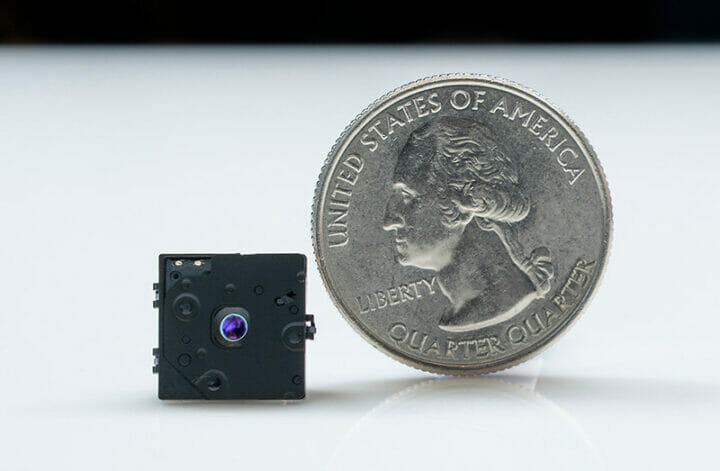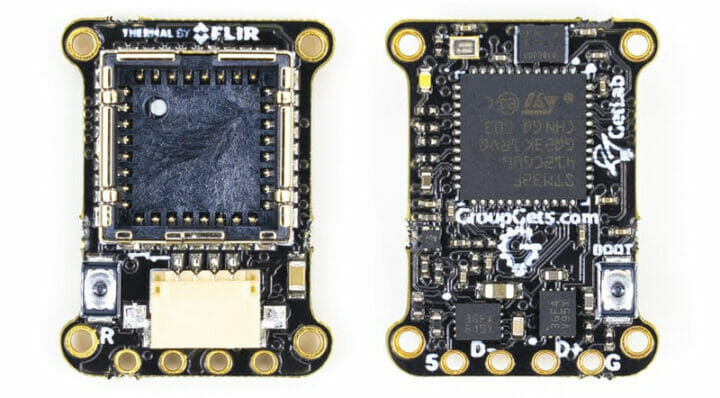Thermal cameras based on FLIR Lepton modules are pretty cool, but also quite expensive. Teledyne FLIR Lepton FS offers a much more cost-effective solution with the non-radiometric 160 x 120 resolution micro thermal camera module going for $99, or about 50% less than other FLIR thermal camera modules.
The lower cost was achieved with some tradeoffs, notably a reduction of thermal sensitivity and scene dynamic range, as well as up to 3% inoperable pixels. But Ron Justin, GroupGets founder, told CNX Software that the lower specs are more than worth it for users only needing an imager, as opposed to a radiometric sensor.
 Lepton FS module specifications:
Lepton FS module specifications:
- Sensor technology – Uncooled VOx microbolometer
- Spectral range – Longwave infrared, 8 μm to 14 μm
- Array format – 160 x 120, progressive scan
- Pixel size – 12 μm
- Effective frame rate 8.7 Hz (commercial application exportable)
- Thermal sensitivity – <75mK NEDT (noise equivalent differential temperature))
- Operability
- Number of non-defective pixels – >97%
- Automatic temperature compensation
- Output image independent of camera temperature.
- Non-uniformity corrections – Integral Shutter
- Scene dynamic range
- High Gain Mode: -10 to 140 degrees C typical
- Low Gain Mode: -10 to 350 degrees C typical
- Image optimization – Factory configured and fully automated
- FOV – horizontal: 57°; diagonal: 71°
- Lens Type- f/1.1
- Output format – User-selectable 14-bit, 8-bit (AGC applied), or 24-bit RGB (AGC and colorization applied)
- Integral solar protection
- Host interfaces – SPI for video data, CCI (I2C-like) for control
- Input supply voltage – 2.8 V, 1.2 V, 2.5 V to 3.1 VIO
- Power consumption
- 150 mW operating
- 650 mW during shutter event
- 5 mW in standby mode
- Dimensions – 11.50 x 12.70 x 6.84 mm (without socket)
- Weight – 0.91 grams
- Temperature Range – Operating: -10C to +65C; storage: -40 C to +80 C
- Shock – 1500 G @ 0.4 ms
While the Lepton FS is not suitable for radiometric applications, the module can still be used for heat, security, and comfort monitoring applications in the fields of home and building automation, heat and occupancy sensing, or security and location monitoring.

Since Lepton FS is mechanically and electrically compatible with FLIR Lepton 2 to 3.5 thermal camera modules, it can fit into existing boards with the appropriate socket such as PureThermal Mini Pro JST-SR, the ESP32-based tCam-Mini IR thermal camera board, OpenMV PureThermal, and others.
Teledyne FLIR Lepton FS is currently available on GroupGets for $99 plus shipping in limited quantities (100 units). You can also get some of the development boards listed above as part of the group buying campaign, including a 10% discount for specific models.

Jean-Luc started CNX Software in 2010 as a part-time endeavor, before quitting his job as a software engineering manager, and starting to write daily news, and reviews full time later in 2011.
Support CNX Software! Donate via cryptocurrencies, become a Patron on Patreon, or purchase goods on Amazon or Aliexpress. We also use affiliate links in articles to earn commissions if you make a purchase after clicking on those links.





I find that this is a reasonable approach. I’m using an MLX90640 that was significantly cheaper but limited to 32×24, and whose accuracy is not used given that you never see twice the same value in two shots anyway. A higher resolution is often much more valuable than fine precision. And even with 3% defective pixels it would remain much more precise than the 32×24 one. For example for most hand-held devices used to detect hot spots on mechanical or electronic devices, as well as those used to detect insulation leaks on buildings wouldn’t care about 3% defective pixels (as long as it’s easy to identify them). And for non-professional applications the temperature ranges above are most often sufficient.
“Effective frame rate 8.7 Hz (commercial application exportable)”
Thanks for the arbitrary restriction, Uncle Sam.
Thanks, I did not exactly understand what that meant the first time. The restrictions may be in place because a higher frame rate could enable military applications maybe?
Yes, it could be used to make a homemade heat-seeking missile or something like that.
It falls under ITAR. FLIR got dinged $30 million for exporting to banned countries e.g. Iran, which are not even allowed to have the 9 Hz cameras.
Obviously, the restrictions are a complete nuisance since people tend to prefer 25/30/50/60 Hz video to choppy 9 Hz.
https://infraredcameras.com/thermal-camera-export-restrictions/
https://www.reuters.com/article/us-flir-systems-usa-settlement/flir-systems-to-pay-30-million-to-settle-u-s-allegations-state-department-idUSKBN1HW2X5
Why are they so expensive?
Years ago people use to adapt SLR cameras to IR black and white sensing, so why is colour sensing so costly ? Especially as this is just heat testing here.
Man, we are talking about completely different wavelengths here, one thing is to remove IR filters, but microbolometers work on completely different principles, color is artificial.
This has nothing to do with IR filters that you have on webcams, we’re talking about far IR, with large wavelengths (8 to 14 µm), not the 850nm ones you typically enable by removing a IR filter and can sometimes see with your own eyes in the dark. These ones are completely different and each pixel should be seen as an individual calibrated sensor that is sensitive to very low energy radiation such as the one emitted even by cold materials.
No temperature resolution, with radiometrics off and that not listed, I guess these are sensor rejects with crippled specs for people that want to see color blobs but not read any meaningful data? Or what am I missing?
For many (non-professional) applications, you just want to distinguish “hot” vs “hotter” vs “cold” vs “colder”. You don’t really care about exact values. That’s enough to see hot air leak around a window or a door, spot faulty components on a board, detect a passing animal in a garage, etc. How many users know how to calibrate their FLIR thermometer’s emissivity setttings to adjust it to the material being measured anyway ? That’s why I think it’s great to propose “junky FLIR for the masses”, there definitely is some demand for this.
But what about those horrible cheap AMG8833 8×8 detectors going for about £51 with screen available on the internet.
> But what about those horrible cheap AMG8833 8×8 detectors
I remember seeing this one but was not interested. 32×24 is already extremely limited. Think that in order to detect and measure a hot 1cm wide cable in a box, you need that box to be no more than 32x24cm. Similarly detecting what small component is hot on a board may require to be extremely close and see only a few squared centimeters area. Thus anything cheaper will require some form of scanning to be of any use :-/